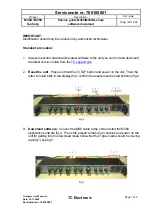
5-3
Figure 5-3
Schematic diagram for WRR queuing
Assume there are eight output queues on a port. WRR assigns each queue a weight value (represented
by w7, w6, w5, w4, w3, w2, w1, or w0) to decide the proportion of resources assigned to the queue. On
a 100 Mbps port, you can configure the weight values of WRR queuing to 5, 3, 1, 1, 5, 3, 1, and 10
(corresponding to w7, w6, w5, w4, w3, w2, w1, and w0 respectively). In this way, the queue with the
lowest priority is assured of 5 Mbps of bandwidth at least, thus avoiding the disadvantage of SP queuing
that packets in low-priority queues may fail to be served for a long time.
Another advantage of WRR queuing is that while the queues are scheduled in turn, the service time for
each queue is not fixed, that is, if a queue is empty, the next queue will be scheduled immediately. This
improves bandwidth resource use efficiency.
WFQ queuing
Figure 5-4
Schematic diagram for WFQ queuing
WFQ is derived from fair queuing (FQ), which is designed for fairly sharing network resources, reducing
the delay and jitter of all traffic. FQ fully consider the interests of all queues to ensure that:
z
Different queues have fair dispatching opportunities, preventing a single queue from being delayed
for too long.
















































